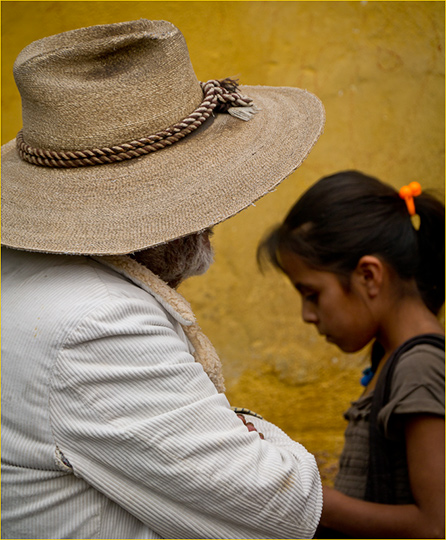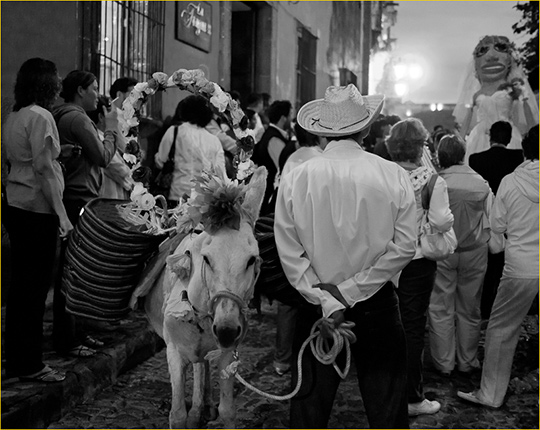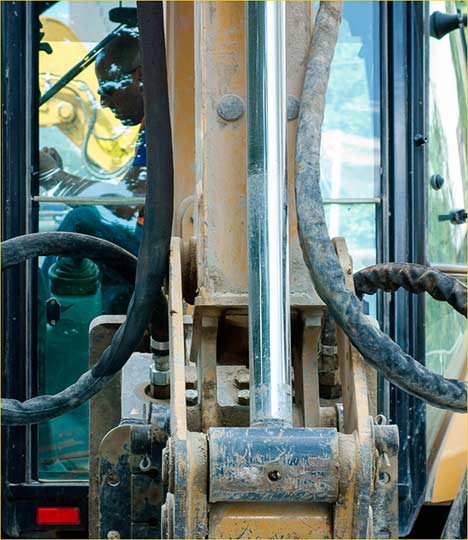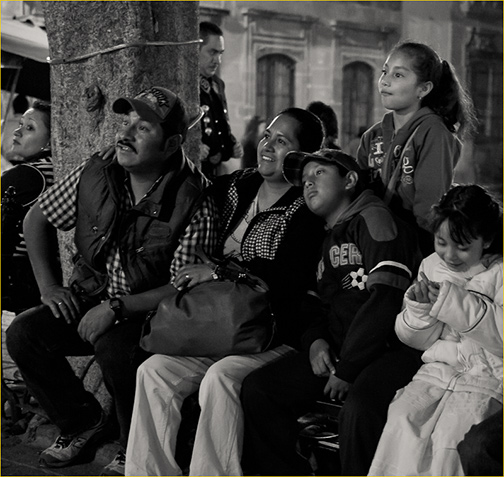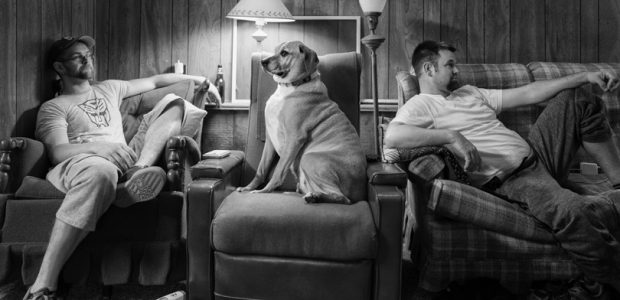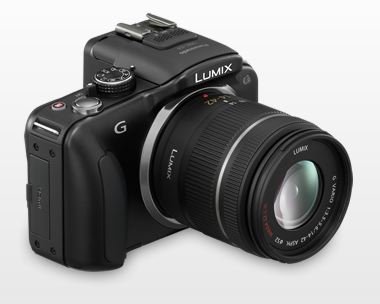
In mid-June, and as luck (and some planning) would have it, I was able to obtain production samples of Panasonic’s newDMC G3camera and also a pre-production sample of the Leica Summilux DG 25mm F1.4lens for testing. This coincided with a two week visit to our place inSan Miguel de Allende, Mexico. This report is based on those two weeks of shooting.
The G3 (US $700 with 14-42mm kit lens / $600 body only) has just started to ship in most countries.
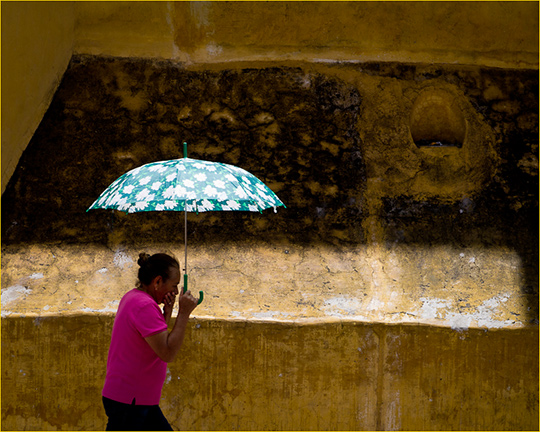
Umbrella and Yellow Wall. San Miguel de Allende, Mexico. June, 2011
Panasonic G3 with 14-140mm @ ISO 160
A Panasonic Taxonomy
Let’s see – currently there’s the GF3, G3 and GH2. Prior to this, and likely still available, there’s the G2, GF2 and G10. Simply put, the H series are the top-of-the-line, the F series are the smallest because they don’t have electronic viewfinders, and the G series (without a letter) are the mid range. The new mid-range camera, and the subject of this report, is the G3. But note that for reasons best know to Panasonic’s marketing folks, the camera itself just has the letter G on the front panel. No number 3. Got it? Good!
Smaller and Better
It needs to be said that this is going to be a briefer, simpler report than my usual ones. Part of the reason for this is that I didn’t get around to using the G3 until well after most of the traditional review sites already had their reviews online. Therefore there’s little need for me to dwell on the minutiae. Instead, I’ll simply touch on the highlights and provide my biased observations after two weeks of use on location.
I’ll cut right to the chase. The new G3 may well be one of the best Micro Four Thirds camera yet. And, except for those that need more versatile video capability, the G3 may in fact be a preferable camera for some users than the top-of-the-line GH2. Let’s see why.
The G3 has a new 15.8MP sensor, just a few pixels shy of the GH2’s 16.1MP. Like the GH2 it has an articulated touch screen and a high resolution electronic viewfinder. It is also some 25% smaller than its predecessor the G2. Build quality is quite good, and though the camera is now about as small as one could want in an interchangeable lens device, handling is still mostly comfortable in spite of the fact that the decent-sized hand grip found on the G2 has now been replaced with a finger nubbin.
I’ll note parenthetically, that the GH2 may just be the smallest full-featured interchangeable lens camera that I have used. Smaller ones, like Panasonic’s GF2, the new G3, let alone even smaller ones like Sony’s NEX series, while usable, and maybe even preferable to some, are just too small for me for all-day shooting using a variety of lenses.
This is an opinion based on the size of my hand, and my shooting style. Others will undoubtedly have different opinions. I am concerned though because the trend we are seeing out of Japan for ever smaller interchangeable lens cameras (the Pentax Q seems to take this to the verge of silliness) is having a negative impact on handling. I know that toys and features sell cameras (as do megapixels), but if a camera doesn’t handle smoothly, IQ becomes almost irrelevant.
Man and Girl Passing. San Miguel de Allende. Mexico. June, 2011
Panasonic G3 with 14-140mm @ ISO 160
It’s the Lenses Stupid (with apologies to James Carvil)
Much is made in magazine and online reviews (and of course by manufacturers) about the size of cameras; and particularly the size relationship between APS-C, Micro Four Thirds, and NEX systems.
There is no doubt that traditional DSLRs (meaning with optical viewfinders) have become much smaller over the past few years, likely as a response to the new mirrorless designs. But, as we see, there is a limit to how small a camera can be made, in large part because of the size and shape of the human hand. Ever smaller camera bodies also lead to the removal of physical controls and substitution by menu based ones, as evidenced by a comparison between the GH2 and the new G3.
But where the Micro Four Thirds format has an edge is in the size of its lenses. A smaller sensor means that lenses can be smaller, and indeed lenses such as the Panasonic 100-300mm are a perfect case in point. This lens, which is equivalent in full-frame terms to a 200–600mm, can be carried on an MFT body all day in one hand. Try that with a lens of comparable focal length and aperture on a DSLR!
This too is theAchilles heelof the NEX system. Sony has managed to make an APS-C camera smaller than an MFT. But, the lenses still need to cover a larger APS-C sized sensor and therefore are limited in how small they can be made.
Donkey and Wedding Party. San Miguel de Allende, Mexico. June, 2011
Panasonic G3 with 25mm f/1.4 DG Summilux @ ISO 1600 @ f/1.4
Power
In making the camera body smaller Panasonic has had to make the battery smaller. This means less shots per charge. This is one of the downsides of downsizing. A spare battery is therefore well worth having, but like all manufacturers Panasonic sees spare and replacement batteries as a significant profit center, making them quite expensive. There are less expensive batteries available. Ebay is the best place to look for them since local retailers typically aren’t interested in handling speciality low margin items like this.
The good news is that the charger supplied (at least in North America) is a small cordless unit with fold out plug. For reasons that passeth understanding many makers are now using USB charging, or worse, chargers that have bulky cables. In my view wall plug chargers are preferable, and I’m happy to see that Panasonic gets this.
Masked Mother and Child. San Miguel de Allende. Mexico. June, 2011
Panasonic G3 with 14-140mm @ ISO 160
Menus and Interface
Allow me to get on my soap box for a moment. Most camera makers menu systems and external controls are designed by engineers, not photographers. Part of the problem is that in the digital era cameras have become gizmos as much as devices for performing photography. Remember when ISO was something you decided in the camera store when you bought a roll of film, not when you set up to take a shot? Remember when focusing meant using your eye and wrist, not 23 cross-sensors. Remember when the only controls available were aperture and shutter speed?
Now, don’t get me wrong. I fully understand that a digital camera inherently requires that more controls be available than does a film camera. The ability to change parameters is valuable. The issue though is how the manufacturer accomplishes the layout and design of the controls, both physical and virtual.
It’s my opinion that only a few makersget it. Leica, on the M9 and S2, is the gold medal winner in my view. Those things that are best done with physical controls are, and those things that are less often needed are available via simple-to-access menus. And, if it isn’t a vital shooting or control function it simply is left off.
Panasonic is part of the mainsteam of Japanese camera makers when it comes to the sheer number of controls available. But, to my way of thinking they have tried their best to provide as many alternative means of accessing those controls that a particular photographer might need.
For example, ISO can be accessed via a dedicated button, through the main menu system, via the Quick Menu system, or via touch screen selection. While this may confuse at first, once the camera becomes familiar it’s easy to choose which one works best for you, and ignore the others.
The same thing applies to having two separate programmable Func. buttons as well as two individual Custom positions on the mode dial. This makes the camera highly configurable. Yes, Nikon, Canonet alhave similar capabilities. But, I find that the way that Panasonic has implemented theirs is just that bit more intuitive and easy to become comfortable with.
I will say though that I prefer the GH2’s full range of mechanical controls to the reduced set on the G3. But, this an inevitable consequence of the camera’s smaller size. I expect that this smaller size, lower weight and lower cost will make the G3 a better seller than the GH2 in any event, now that the GH2 doesn’t have a megapixel advantage.
Waiting. San Miguel de Allende, Mexico. June, 2011
Panasonic G3 with 25mm f/1.4 DG Summilux @ ISO 160 @ f/2.2
No Eye Sensor
The EVF on the G3 is very welcome, as I’m one of those old farts that finds shooting with an LCD at arms length to be an unpleasant and unstable way to do photography. As EVF’s go, it’s one of the best. But I am disappointed to note that unlike on the GH2 there is no eye sensor when bringing the camera to eye level so that it automatically switches the LCD off and the LCD on. It would appear that this omission is the result of downsizing, and likely cost reduction as well.
After two weeks of daily shooting with the G3 I have to report that this is not a trade-off that I am happy to accept. I shoot with the EVF 95% of the time and having to remember to press the LCD/EVF button whenever I need to change a setting become tedious and annoying very quickly.
Two Girls. San Miguel de Allende. Mexico. June, 2011
Panasonic G3 with 14-140mm @ ISO 250
The Touch Screen
I have no problem with the touch screen, though I know that some people love them while others hate them (on camera’s at least). I don’t use it much, because I find that the external controls provide access to most of the things that I want. But, being able to touch the screen on the point of intended focus a real benefit, and if the camera is tripod mounted one can even use the touch screen to rack autofocus while shooting video.
Movie and iA Buttons
Panasonic’s approach to ease of user control is also evidenced by the dedicated iA button. This places the camera is fully automatic stills shooting mode regardless of how any of the other controls are set. So, for example, you could be in fully manual mode, set to shoot an HDR bracket with manual focus, and all of a sudden a spontaneous moment occurs that you want to capture. Press the iA button and you’re good to go. A blue illuminated ring around the button lights up to remind you that you’ve handed full control over to the camera. Press it again and you’re back to your preset manual mode.
Unlike the top-of-the-line GH2, video on the G3 is fully automatic. There is a dedicated video start/stop button on the rear panel, and when pressed you can shoot video regardless of the camera’s stills settings. The only real control over video shooting that you have is to choose 720 or 1080 modes, a motion JPG or AVCHD. Exposure compensation is available when shooting video.
There are other video compromises as compared to the GH2, including lack of HDMI output and the use of Interlaced output rather than Progressive, even though the sensor output is Progressive. There is also no external mic input. Clearly Panasonic wants to do whatever it can to protect its GH2 video eminence.
The one area where the G3, like the GH2, excels is rapid and almost silent autofocus while filming.
Autofocus
The AF on the G3 is in the same league as that on the GH2. Indeed there is little left to be desired. It’s fast, usually accurate, and quiet. All the usual choices are available, including AF tracking, Face Detection, 23 point (covering the full screen), single point, and Pinpoint. The latter is quite interesting in that it magnifies the image 5X. Then, touching the shutter release, or an AF lock button if you’ve programmed it, or the screen itself, allows you to fix focus and / or shoot.
Confirmation Drive By. San Miguel de Allende. Mexico. June, 2011
Panasonic G3 with 14-140mm @ ISO 160
The G3 Bottom Line
There are a wealth of additional features and capabilities to the G3 that I have not covered. This includes the built-in flash, hot shoe, and speciality shooting modes when shooting JPGs. I didn’t use any of these so don’t have much to report.
What I did do was shoot at just about every ISO available in raw mode, processing the files in a pre-release version of one of the popular third party programs. Overall image quality was very good indeed. The jump from 12MP to 16MP has not detracted from IQ in any visible way. At ISO 160 and 200 the camera is as clean as one could wish. No, not as clean as a Leica M9, for example, but totally acceptable for just about any use, and prints up to about 13X19″.
ISO 400 and 800 start to show noise, but no worse that similarly priced cameras from Nikon, Canon, Pentax, etc. A bit of luminance smoothing in Lightroom and the images are certainly usable for most any purpose. Beginning at ISO 1600 noise begins to be problematic, and though it can be reduced, detail resolution starts to suffer.
Dynamic range seems to be comparable to other cameras in this price range. Of course colour rendition is a function of image processing. Not having shot JPGs I can’t comment on how the camera’s internal processing does. From raw files one can accept a particular raw converter’s colour interpretation or use the Colorchecker Passport to create ones own preferred interpretation.
In the final analysis the Panasonic G3 is a very attractive offering in its price range. While not as versatile or full featured as the GH2, the G3’s lower price and smaller size is an attractive compromise, especially for those not needing advanced video features.
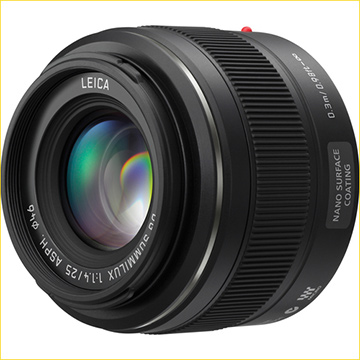
Back in 2007 Panasonic introduced its Leica 25mm f/1.4 Summiliux D lens for Four Thirds cameras. This was an excellent lens optically, and received a most favourable review from Pop Photo magazine and others at the time. It was the fastest lens made for Four Thirds, but sales weren’t that brisk at its $800 street price. It is still available, though the price has risen to some $1,100 due to currency revaluations.
But, Four Thirds turned out to be a bit of a dead-end, which I must say I predicted at the time. When Micro Four Thirds (MFT) came on strong, though lenses like the Summilux D could be used on various Panasonic and Olympus camera bodies via an adaptor, the combination proved bulky, and autofocus was possible, but slow and noisy.
Now, in mid-2011, Panasonic has addressed the need for a fast high quality prime lens by bringing out a version in MFT mount, the Leica 25mm f/1.4 Summilux D. It is smaller, lighter, has much faster autofocus, and with an initial street price of US $600 it costs nearly 50% less than the older lens. The lens will start shipping in August.
Night Portrait. San Miguel de Allende, Mexico. June, 2011
Panasonic G3 with 25mm f/1.4 DG Summilux @ ISO 1600 @ f/1.4
In Hand
The new 24mm Summilux, like all Panasonic lenses with the Leica brand, should not be confused with actual Leica lenses. They are made in Japan by Panasonic, not Leica. We are told that they are Panasonic designs, and specification and manufacturing are overseen by Leica technicians. That’s fine, but the materials and build is not in the same league as an actual M Summilux, for example.
Now, don’t misunderstand. Build quality is fine. But this is a lens designed for MFT, not a Leica M. It also costs under $600, while a comparable 50mm Leica M f/1.4 Summulux costs over $3,000 more.
Not having a test bench at my disposal any longer, I can’t give you MTF or SQF charts and tables. What I did instead (wait for it – and I know it’s hard to fathom) is take photographs, mostly at night, and usually with the lens at f/1.4 and at ISO 1600.
I found little to fault and a lot to like. The lens’ resolution wide open is very good in the center, and naturally softens toward the edges, though by less than one would imagine. Vignetting is modest and I rarely bothered to correct it in post processing. Flare is minimal, even wide open.
Note that the lens comes with a largish rectangular lens hood, which I always used, and this may account for the low flare experienced as much as anything else. I was disappointed though that the hood isn’t designed to reverse mount on the lens for storage.
Because the sample lens that I used was pre-production I have not done any rigorous comparisons with alternatives such as the older D Summulix, the 20mm f/1.7 and, of course, the 25mm f/0.95 Voigtlander Nokton. Maybe when production lenses become available I’ll revisit doing such a comparison.
June, 2011
You May Also Enjoy...
American Family – Michael Reichmann Endowment Grant Recipient
Zach Roberts Luminous Endowment Michael Reichmann Grant Recipient An American Family I was born and raised in Strasburg, PA and lived in New York
Calibration
System Colour Calibration April, 2000 This article is now a couple of years old and has become dated, as there are several new generations
